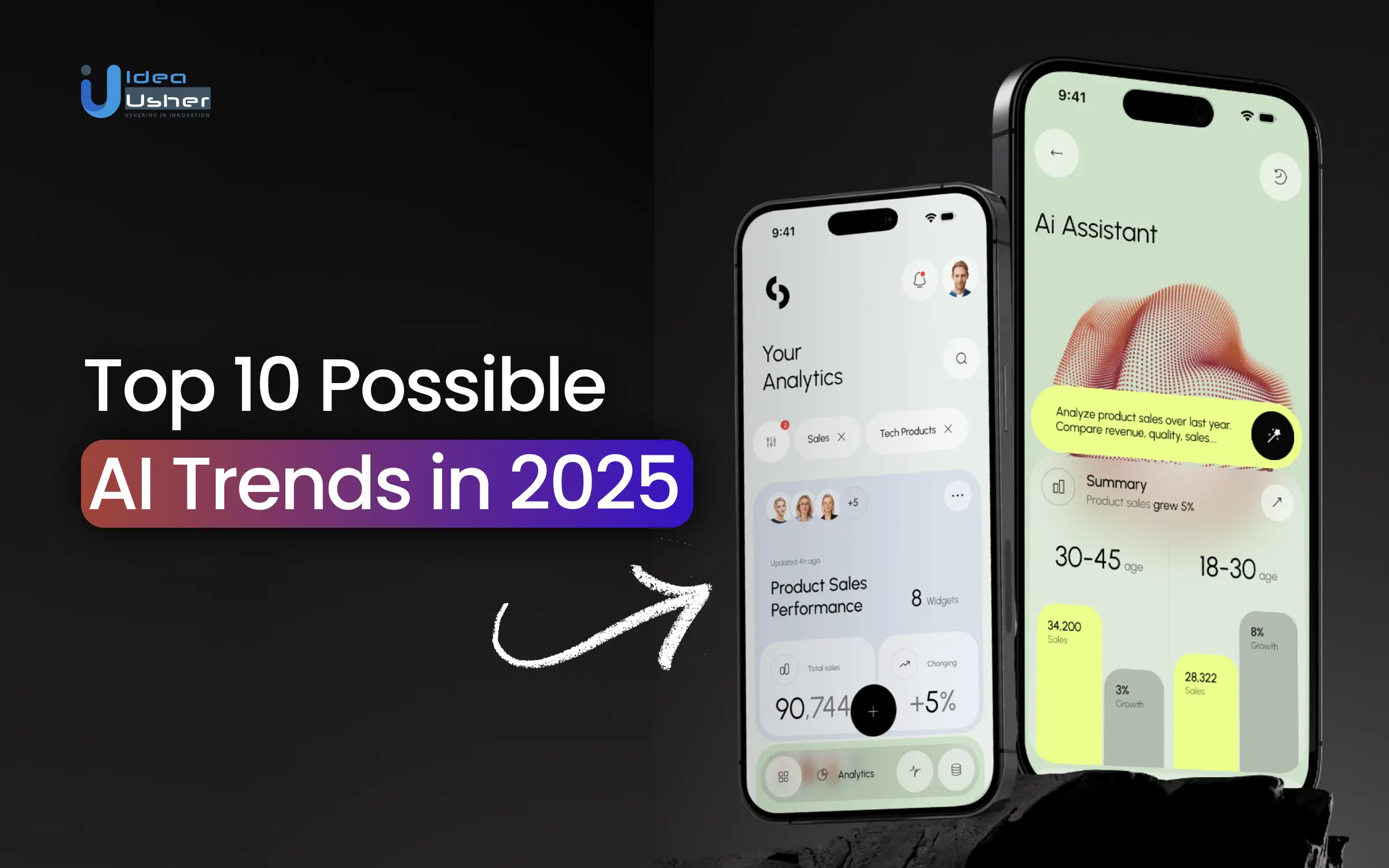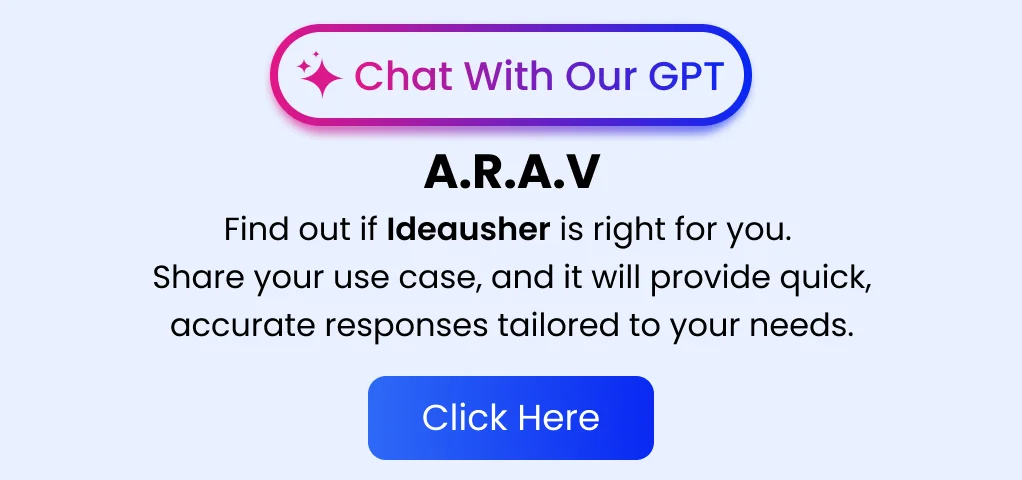These days, businesses face a lot of challenges—like tougher competition, rising costs, and changing customer expectations. To stay ahead, companies need to keep innovating and adapt to new technologies. One of the biggest game-changers right now is AI. By staying on top of AI trends, businesses can open up new opportunities, improve efficiency, and create better experiences for their customers. AI can help by automating routine tasks, analyzing large amounts of data to reveal valuable insights, and even personalizing products and services to meet each customer’s unique needs.
The AI market is growing fast, reaching about $200 billion in 2023, and is expected to skyrocket to over $1.8 trillion by 2030. This rapid growth shows that more and more businesses are jumping on board with AI, leading to a wave of exciting new solutions—especially in the U.S. In this blog, we’ll take a look at the top ten AI trends that could shape the future by 2025. Let’s dive in and explore what’s next for AI!
Key Market Takeaways for Artificial Intelligence
According to Statista, the AI market is growing at an incredible pace, expected to jump from around $200 billion in 2023 to over $1.8 trillion by 2030. This massive growth is being fueled by the increasing demand for automation and efficiency across a wide range of industries.
Source: Statista
Industries like healthcare, finance, and retail are leading the charge when it comes to AI adoption, thanks to their complex operations and vast data needs. For example, in healthcare, AI is helping with robot-assisted surgeries and virtual nursing assistants, improving both patient care and hospital efficiency. In finance, AI is enhancing fraud detection and risk assessments, making operations more secure and effective. Plus, in marketing and advertising, generative AI is enabling companies to create personalized content at scale, boosting engagement and conversion rates.
What’s really exciting is how companies—both big tech giants and innovative startups—are teaming up to push AI forward. A great example is the partnership between Microsoft and G42 in the UAE, where Microsoft invested $1.5 billion to bring its AI tech into G42’s operations. This collaboration is set to improve public sector services and drive digital transformation in the region. Similarly, OpenAI is working with G42 to develop generative AI models tailored to industries like finance and healthcare, further highlighting how AI is shaping the future across various sectors.
Work with Ex-MAANG developers to build next-gen apps schedule your consultation now
Can an AI be a Strong Business Investment?
AI is a smart business investment because it offers huge opportunities for efficiency, innovation, and growth. By using AI, businesses can automate repetitive tasks and streamline operations, which will lead to better results. For entrepreneurs, this means lower labor costs and improved productivity, as AI can handle tasks like customer service and data analysis, freeing up time for more valuable work. For example, businesses using AI chatbots have seen customer service costs drop by up to 30%, demonstrating the real financial benefits of AI.
But AI doesn’t just help businesses run more efficiently—it can also unlock new revenue opportunities. By analyzing huge sets of data, AI can spot trends and customer preferences that might otherwise go unnoticed. This insight allows companies to create more targeted products, services, and marketing strategies, ultimately boosting sales and improving customer loyalty. In fact, a McKinsey report predicts that AI could contribute an additional $13 trillion to the global economy by 2030, with businesses adopting AI seeing GDP growth of up to 26%. As companies increasingly embrace AI, they gain the flexibility to adapt to market shifts quickly.
The financial benefits of AI are clear. Businesses that leverage AI can cut costs, increase sales, and drive long-term growth. With AI, entrepreneurs have a powerful tool to position their companies for success in the future.
Speaking of AI’s potential…
Recently, AWS has launched a $100 million initiative called the AWS Generative AI Innovation Center. This program is designed to support businesses and partners working with generative AI by connecting them with AWS experts like data scientists, engineers, and strategists. The goal is to help companies innovate faster and succeed in the rapidly growing AI space. With this funding, AWS is solidifying its position as a leader in the AI race, empowering businesses to create cutting-edge solutions.
Jeff Bezos, Amazon’s founder, shared his excitement about AI’s future, saying,
“We’re at the beginning of a golden age of AI. Recent advancements have already led to inventions that once seemed like science fiction—and we’ve only scratched the surface of what’s possible.”
With all these exciting developments, now is the perfect time for businesses to invest in AI solutions and take advantage of the opportunities AI can bring!
Top 10 Possible AI Trends in 2025
Here are the top ten possible AI trends in 2025,
1. AI-Powered Personal Assistants
AI-powered personal assistants are becoming essential tools for businesses. These systems can manage schedules, handle customer inquiries, and perform various administrative tasks. By automating these functions, companies can enhance productivity and improve customer satisfaction through timely responses.
Example: X.AI
X.AI developed an AI personal assistant named “Amy” that schedules meetings and manages calendars for users.
- x.ai has facilitated over 1 million meetings since its launch.
- The platform integrates with popular calendar applications like Google Calendar and Microsoft Outlook.
x.ai’s personal assistant significantly reduces the time spent on scheduling meetings, allowing professionals to focus on more critical tasks. Users report saving an average of 10 hours per month on scheduling-related activities.
2. AI in Content Creation
AI is revolutionizing content creation by enabling companies to generate high-quality written material quickly and efficiently. Tools powered by NLP can produce articles, social media posts, and marketing content at scale.
Example: Scalenut
Scalenut is an AI-powered content marketing platform that helps businesses scale their content production through SEO optimization and automated writing tools.
- Launched in September 2021, Scalenut has grown to over 100,000 users and generates approximately $1.2 million annually.
- The platform has helped users increase organic traffic by up to 25% within months of implementation.
By streamlining the content creation process, Scalenut allows businesses to produce high-quality content more efficiently. Users report a 30% increase in content output while reducing costs by 62%, enabling them to maintain a competitive edge.
3. AI in Supply Chain Optimization
The integration of AI into supply chain management is enhancing the ability of companies to predict demand, optimize inventory levels, and improve logistics. By analyzing vast amounts of data in real time, businesses can make informed decisions that lead to reduced costs and improved service delivery.
Example: ClearMetal
ClearMetal provides an AI-driven supply chain visibility platform that helps companies optimize inventory management and demand forecasting.
Key Stats:
- ClearMetal’s platform has improved inventory accuracy by up to 90% for its clients.
- The company has raised over $25 million in funding from investors like Accel and Bullpen Capital.
By leveraging AI algorithms, ClearMetal enables businesses to make data-driven decisions regarding inventory levels and supply chain operations.
4. Enhanced Automation through AI
Companies are leveraging AI to automate repetitive tasks, which allows employees to focus on more strategic initiatives. This trend not only boosts productivity but also reduces operational costs, making businesses more competitive in their respective markets.
Example: Automation Anywhere
Automation Anywhere is a cloud-based RPA platform that helps businesses automate repetitive tasks like data entry and customer service. It’s transforming how organizations work by saving time and boosting efficiency.
- Automation Anywhere reported revenue of $300 million in 2023, showcasing significant growth in the competitive RPA market.
- The platform serves over 3,500 organizations worldwide, including Fortune 500 companies such as Cisco, Siemens, and General Electric.
Businesses using Automation Anywhere have reported operational cost reductions of up to 40%, with many achieving ROI within just a few months of implementation.
5. Voice Cloning and Natural Language Processing
Advancements in voice cloning and NLP are enabling companies to create more engaging customer interactions. Businesses are utilizing these technologies for personalized marketing campaigns and customer service applications, allowing for a more human-like interaction that enhances user experience.
Example: Descript
Descript is an audio and video editing tool that uses voice cloning technology to create realistic voiceovers for content creators.
Key Stats:
- Descript has over 10 million users and has raised $50 million in funding.
- The platform’s Overdub feature allows users to create voiceovers that sound like their own voice with just a few minutes of audio training.
Descript enables content creators to produce high-quality audio without the need for extensive recording sessions.
6. Real-Time Data Processing with Edge Computing
Edge computing is emerging as a significant trend in data processing, allowing companies to analyze data closer to the source rather than relying solely on centralized cloud systems. This capability enables real-time insights that can drive immediate business decisions, enhancing responsiveness in dynamic market conditions.
Example: FogHorn Systems
FogHorn Systems specializes in edge intelligence software that processes data at the source for real-time analytics in industrial applications.
- FogHorn’s solutions have been deployed in over 100 locations across various industries, including manufacturing and energy.
- The company reported a reduction in latency by up to 90% compared to traditional cloud-based systems.
By processing data at the edge, FogHorn enables businesses to respond quickly to operational changes, improving efficiency and reducing downtime.
7. AI-Driven Decision Making
AI is increasingly being used to support decision-making processes within organizations. Companies are adopting AI analytics tools that provide insights based on historical data and predictive modeling. This trend empowers businesses to make data-driven decisions that align with their strategic goals.
Example: DataRobot
DataRobot provides an automated machine learning platform that empowers organizations to make data-driven decisions through predictive analytics.
- DataRobot serves over 1,000 customers worldwide, including Fortune 500 companies.
- The platform claims a reduction in model development time from weeks to hours for its users.
By automating the machine learning process, DataRobot allows businesses to leverage predictive analytics without requiring extensive data science expertise.
8. Integration of AI with IoT
The integration of AI with the IoT is creating smarter environments across various industries. Companies are using AI algorithms to analyze data collected from connected devices, leading to improved operational efficiencies and enhanced product offerings.
Example: Azure IoT Hub
Azure IoT Hub is a cloud-based platform developed by Microsoft that facilitates the integration of IoT devices with cloud applications. It enables businesses to connect, monitor, and manage billions of devices securely while providing real-time analytics and insights.
- Azure IoT Hub serves thousands of customers globally, including major enterprises like BMW and Siemens, who utilize the platform for their IoT solutions.
- The platform can handle millions of connected devices, supporting the needs of large-scale IoT deployments across various industries.
Microsoft has invested heavily in Azure, with the cloud division generating over $75 billion in revenue in 2022, demonstrating its commitment to advancing cloud and IoT technologies.
9. Cognitive Document Processing
With advancements in machine learning, startups are focusing on cognitive document processing to automate the extraction of data from unstructured documents. Companies like DocuSign are utilizing AI to streamline contract management processes, enabling organizations to handle document-centric tasks more efficiently.
Example: Quantiphi
Quantiphi is an AI and machine learning company that specializes in cognitive document processing solutions. The startup focuses on automating the classification and extraction of content from unstructured documents, particularly in sectors like financial services.
- The system can process over 12,000 documents per hour.
- Achieved an accuracy rate of 80% in data extraction.
The implementation led to potential savings of around 40% in operational costs.
10. Collaborative AI Platforms
The trend towards collaboration is evident in startups that create platforms allowing multiple users or teams to work together using AI tools. These collaborative environments foster innovation and enable organizations to leverage diverse expertise in developing AI solutions tailored to their needs.
Example: Harvey
Harvey is an AI startup founded in 2022 that focuses on creating collaborative platforms for legal professionals. The platform leverages AI to assist lawyers in researching cases, drafting contracts, and finding legal precedents efficiently.
- Harvey has raised over $106 million in funding since its inception.
- The platform is utilized by more than 10,000 lawyers, including elite law firms like Allen & Overy and Macfarlanes.
- Users report significant time savings in contract drafting and legal research processes.
The platform fosters collaboration among legal teams by enabling multiple users to work together seamlessly on documents and cases
Conclusion
I think that understanding and leveraging AI trends is essential for businesses to succeed in today’s competitive environment. By embracing AI technologies, companies can automate processes and improve the overall customer experience.
Developing AI-powered solutions, like chatbots, recommendation systems, and predictive analytics tools, can boost efficiency, reduce costs, and drive revenue growth. Staying up to date with the latest AI advancements is key for positioning a business for long-term success!
Looking to Develop an AI Solution for Your Business?
At Idea Usher, we bring over 500,000 hours of coding expertise to help transform your business. Our team of AI experts is passionate about creating innovative solutions. Whether it’s building intelligent chatbots to enhance customer interactions, developing predictive analytics models to streamline your operations, or automating routine tasks, we’re here to help. We focus on delivering personalized, data-driven solutions that give you valuable insights and improve customer experiences. Let’s work together to unlock the full potential of AI and take your business to the next level!
Work with Ex-MAANG developers to build next-gen apps schedule your consultation now
FAQs
Q1: How to develop an AI solution?
A1: To develop an AI solution, start by defining the problem and gathering relevant data. Choose the right machine learning techniques, clean and preprocess the data, then split it into training and testing sets. Train the model, evaluate its performance, and fine-tune it. Once optimized, deploy the model and monitor it for improvements.
Q2: What are the features of an AI solution?
A2: AI solutions typically include data processing, machine learning algorithms, automation, and capabilities like NLP and computer vision. They can make predictions, automate tasks, and improve over time by learning from new data.
Q3: What is the next big thing in AI?
A3: The next big thing in AI is general artificial intelligence, systems that can perform any task a human can. Other exciting trends include explainable AI, quantum computing, and AI-driven creativity in fields like art and music.
Q4: What is the cost of developing an AI solution?
A4: The cost of developing an AI solution depends on its complexity. Simple projects might cost a few thousand dollars, while advanced systems can run into the hundreds of thousands or more. Key costs include data acquisition, model development, infrastructure, and maintenance




















